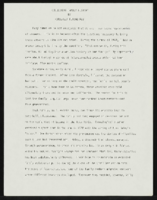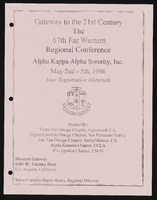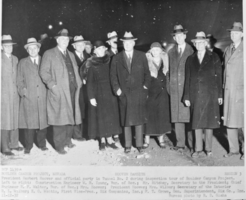Search the Special Collections and Archives Portal
Search Results

Meeting minutes for Consolidated Student Senate, University of Nevada, Las Vegas, February 09, 1982
Date
Archival Collection
Description
Text

"Collecting Family History": article draft by Roosevelt Fitzgerald
Date
Archival Collection
Description
From the Roosevelt Fitzgerald Professional Papers (MS-01082) -- Drafts for the Las Vegas Sentinel Voice file. On Black families in the United States and family reunions.
Text

Alpha Kappa Alpha Sorority 67th Far Western Regional conference program
Date
Archival Collection
Description
From the Alpha Kappa Alpha Sorority, Incorporated, Theta Theta Omega Chapter Records (MS-01014) -- Chapter records file.
Text

Transcript of interview with Jonathan Sparer by Stefani Evans and Claytee White, August 29, 2016
Date
Archival Collection
Description
Text

Transcript of interview with Juan Saa by David G. Schwartz, November 21, 2016
Date
Archival Collection
Description
Text
Bezard, Pierre, 1924-2020
"Pierre was born June 16, 1924 in Paris, France. He survived WWII as a prisoner in a Nazi work camp where he met his lifelong friend Louis Juif. After the war, he returned to his family and began his career working backstage in theater. Although he never had much formal education, Pierre quickly ascended to the position of stage director, managing numerous productions including the Lido in Paris, Casino de Paris in Las Vegas, Ballet de Roland Petit, Solid Gold Las Vegas, Vive Les Girls, as well as touring shows worldwide.
Person
The Front Page, approximately 1927 to 1939
Level of Description
Scope and Contents
The Front Page sub-series (approximately 1927-1939) is comprised of materials pertaining to the production process of The Caddo Company's April 4, 1931 release of The Front Page. The sub-series contains advertising and publicity, administrative, financial, legal, and production and direction, and story development records. Director Lewis Milestone, along with editor Duncan Mansfield and writers Ben Hecht, Charles MacArthur, and Bartlett Cormack helped the film earn Academy Awards nominations for Best Director and Best Picture in 1929. The black-and-white photographic prints and negatives, primarily attributed to Newton Hopcroft, depict set and production stills of the principal and supporting cast and locations in the film.
Advertising and publicity records include newspaper clippings detailing the film’s release, articles of local advertising campaigns, and publicity stills of principal and supporting cast members. Administrative records include correspondence pertaining to the editing, censorship, and distribution of the film, as well as shipping receipts. Legal records include supporting actor and domestic distribution contracts. Production and direction records include production stills of principal and supporting cast, interior and exterior sets, and a sound and production daily report ledger. The story development records include production scripts, as well as cutting continuities and dialogue scripts for domestic and international releases.
Archival Collection
Collection Name: Howard Hughes Film Production Records
Box/Folder: N/A
Archival Component

Film transparency of Herbert Hoover and his party touring the Boulder Canyon Project, November 12, 1932
Date
Archival Collection
Description
Image
